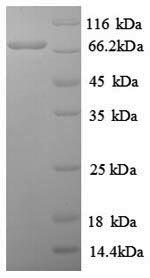Recombinant Human Proto-oncogene c-Rel (REL) , partial
CAT:
399-CSB-EP019552HU-02
Size:
100 µg
Price:
Ask
- Availability: 24/48H Stock Items & 2 to 6 Weeks non Stock Items.
- Dry Ice Shipment: No




Recombinant Human Proto-oncogene c-Rel (REL) , partial
- CAS Number: 9000-83-3
- Gene Name: REL
- UniProt: Q04864
- Expression Region: 3-616aa
- Organism: Homo sapiens
- Target Sequence: SGAYNPYIEIIEQPRQRGMRFRYKCEGRSAGSIPGEHSTDNNRTYPSIQIMNYYGKGKVRITLVTKNDPYKPHPHDLVGKDCRDGYYEAEFGQERRPLFFQNLGIRCVKKKEVKEAIITRIKAGINPFNVPEKQLNDIEDCDLNVVRLCFQVFLPDEHGNLTTALPPVVSNPIYDNRAPNTAELRICRVNKNCGSVRGGDEIFLLCDKVQKDDIEVRFVLNDWEAKGIFSQADVHRQVAIVFKTPPYCKAITEPVTVKMQLRRPSDQEVSESMDFRYLPDEKDTYGNKAKKQKTTLLFQKLCQDHVETGFRHVDQDGLELLTSGDPPTLASQSAGITVNFPERPRPGLLGSIGEGRYFKKEPNLFSHDAVVREMPTGVSSQAESYYPSPGPISSGLSHHASMAPLPSSSWSSVAHPTPRSGNTNPLSSFSTRTLPSNSQGIPPFLRIPVGNDLNASNACIYNNADDIVGMEASSMPSADLYGISDPNMLSNCSVNMMTTSSDSMGETDNPRLLSMNLENPSCNSVLDPRDLRQLHQMSSSSMSAGANSNTTVFVSQSDAFEGSDFSCADNSMINESGPSNSTNPNSHGFVQDSQYSGIGSMQNEQLSDSFPYEF
- Tag: N-terminal 6xHis-B2M-tagged
- Source: E.coli
- Field of Research: Transcription
- Assay Type: In Stock Protein
- Relevance: Proto-oncogene that may play a role in differentiation and lymphopoiesis. NF-kappa-B is a pleiotropic transcription factor which is present in almost all cell types and is involved in many biological processed such as inflammation, immunity, differentiation, cell growth, tumorigenesis and apoptosis. NF-kappa-B is a homo- or heterodimeric complex formed by the Rel-like domain-containing proteins RELA/p65, RELB, NFKB1/p105, NFKB1/p50, REL and NFKB2/p52. The dimers bind at kappa-B sites in the DNA of their target genes and the individual dimers have distinct preferences for different kappa-B sites that they can bind with distinguishable affinity and specificity. Different dimer combinations act as transcriptional activators or repressors, respectively. NF-kappa-B is controlled by various mechanisms of post-translational modification and subcellular compartmentalization as well as by interactions with other cofactors or corepressors. NF-kappa-B complexes are held in the cytoplasm in an inactive state complexed with mbers of the NF-kappa-B inhibitor (I-kappa-B) family. In a conventional activation pathway, I-kappa-B is phosphorylated by I-kappa-B kinases (IKKs) in response to different activators, subsequently degraded thus liberating the active NF-kappa-B complex which translocates to the nucleus. The NF-kappa-B heterodimer RELA/p65-c-Rel is a transcriptional activator.
- Purity: Greater than 90% as determined by SDS-PAGE.
- Activity: Not Test
- Length: Partial
- Form: Liquid or Lyophilized powder
- Buffer: If the delivery form is liquid, the default storage buffer is Tris/PBS-based buffer, 5%-50% glycerol. If the delivery form is lyophilized powder, the buffer before lyophilization is Tris/PBS-based buffer, 6% Trehalose, pH 8.0.
- Reconstitution: We recommend that this vial be briefly centrifuged prior to opening to bring the contents to the bottom. Please reconstitute protein in deionized sterile water to a concentration of 0.1-1.0 mg/mL.We recommend to add 5-50% of glycerol (final concentration) and aliquot for long-term storage at -20℃/-80℃. Our default final concentration of glycerol is 50%. Customers could use it as reference.
- Function: Proto-oncogene that may play a role in differentiation and lymphopoiesis. NF-kappa-B is a pleiotropic transcription factor which is present in almost all cell types and is involved in many biological processed such as inflammation, immunity, differentiation, cell growth, tumorigenesis and apoptosis. NF-kappa-B is a homo- or heterodimeric complex formed by the Rel-like domain-containing proteins RELA/p65, RELB, NFKB1/p105, NFKB1/p50, REL and NFKB2/p52. The dimers bind at kappa-B sites in the DNA of their target genes and the individual dimers have distinct preferences for different kappa-B sites that they can bind with distinguishable affinity and specificity. Different dimer combinations act as transcriptional activators or repressors, respectively. NF-kappa-B is controlled by various mechanisms of post-translational modification and subcellular compartmentalization as well as by interactions with other cofactors or corepressors. NF-kappa-B complexes are held in the cytoplasm in an inactive state complexed with members of the NF-kappa-B inhibitor (I-kappa-B) family. In a conventional activation pathway, I-kappa-B is phosphorylated by I-kappa-B kinases (IKKs) in response to different activators, subsequently degraded thus liberating the active NF-kappa-B complex which translocates to the nucleus. The NF-kappa-B heterodimer RELA/p65-c-Rel is a transcriptional activator.
- Molecular Weight: 82.5 kDa
- References & Citations: N-terminal acetylome analyses and functional insights of the N-terminal acetyltransferase NatB.Van Damme P., Lasa M., Polevoda B., Gazquez C., Elosegui-Artola A., Kim D.S., De Juan-Pardo E., Demeyer K., Hole K., Larrea E., Timmerman E., Prieto J., Arnesen T., Sherman F., Gevaert K., Aldabe R.Proc. Natl. Acad. Sci. U.S.A. 109:12449-12454 (2012)
- Storage Conditions: The shelf life is related to many factors, storage state, buffer ingredients, storage temperature and the stability of the protein itself. Generally, the shelf life of liquid form is 6 months at -20℃/-80℃. The shelf life of lyophilized form is 12 months at -20℃/-80℃.
